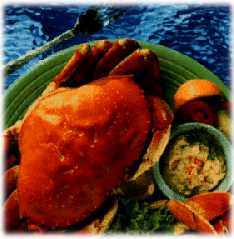|
History
Dungeness crab, reportedly named
after a small fishing
village on the Strait of Juan de Fuca in Washington state, have been
harvested
commercially along the Pacific Coast since the late 1880's. Abundance
of
these highly prized crustanceans fluctuates. Total coastwide production
ranges from 35-55 million lbs. annually.
Method of Catch
Dungeness
crabs are caught in circular steel traps commonly called "pots".
Weighing
anywhere from 60 to 125 lbs. and measuring 36" to 48" across, each pot
has a length of line with a buoy attached to mark its location for
retrieval.
The pots are baited with herring, squid and razor clams to attract the
bottom-dwelling crabs during the one to three day "soak" period. Only
male
crabs measuring at least 6 1/4 in. across the shell may be harvested,
with
all female and small males returned to the sea to insure healthy stocks
for future harvest. The average boat fishes 250-300 pots in depths
ranging
from 5-50 fathoms (30-300 ft.). Dungeness crabs are kept alive in tanks
on-board the vessel, until they are delivered to a shoreside processor.
Vessels range from the small wooden troller with its two-man crew, to
the
large steel combination vessel with a four-man crew capable of fishing
around the clock in all kinds of weather.
Crab Facts
Reproduction and life history:
Dungeness crabs mate from
spring through the fall. The male crabs are polygamous--each male crab
may mate with more than one female crab. This may be an important
factor
in maintaining the reproductive
viability of this species because only
male crabs can be harvested in commercial and personal use fisheries.
Male
crabs mate only with female crabs that have just molted (shed their old
exoskeleton). Fertilization of the egg does not occur at the time of
mating.
The female crab stores the sperm until her eggs are fully developed.
The
eggs are fertilized when the female extrudes them under her abdomen
where
they are carried until hatching. A large female crab can carry 2.5
million
eggs.
After hatching, the young crabs
are planktonic and swim
freely away from the female. Larval development takes from 4 months to
as long as a year. Six successive stages (5 zoea and 1 megalopa) occur
before the crabs molt into the first juvenile stage. These crabs grow
each
time they molt. During the first two years both sexes grow at similar
rates
but after two years the female crabs grow more slowly than the males.
Sexual
maturity may be reached at three years. At 4 to 5 years of age, a
Dungeness
crab can be over 6 1/2 inches in shell width and weigh between 2 and 3
pounds. A large male Dungeness crab can exceed 10 inches in shell
width.
The estimated maximum life span of this crab is between 8 and 13 years.
Dungeness crabs are
widely distributed subtidally and
prefer a sandy or muddy bottom in salt water. However, they are
tolerant
of salinity changes and can be found in estuarine environments.
Dungeness
crabs foraging behavior coincides with their habitat. These crabs
scavenge
along the sea floor for organisms that live partly or completely buried
in the sand. They are carnivores, and their diet can include shrimp,
mussels,
small crabs, clams, and worms. Dungeness crabs are found only in the
North
Pacific. They range from Central California to The Gulf of Alaska.
Live Dungeness crabs are
purplish-brown in color. Cooking
brings out the bright orange color they are famous for. An average of
25%
of a Dungeness crab's weight is edible "meat", making it one of the
meatiest
crabs available. Dungeness Crab is an excellent source of high-quality
protein, containing all of the essential amino acids, while low in fat
and calories. You'll also find a rich supply of important minerals such
as zinc, copper, calcium, magnesium and iron. It's a natural for
health-conscious
customers.
Serving
size: 3 oz. -- Cooked, Edible Portion
Calories 93.6
Protein 19 g
Total Fat 1.06 g
Saturated 0.143 g
Monounsaturated 0.182 g
Polyunsaturated 0.346 g
Carbohydrates 0.808 g
Sodium 321 mg
Potassium 347 mg
Magnesium 49.3 mg
Cholesterol 64.6 mg
Source: Data provided by the Food
Processor computerized
nutrition system, ESHA Research, Salem, OR.
Dungeness Crab is
one of the most festive crab dishes
you can menu. It is classically served whole, either hot or cold, and
paired
with melted butter or dipping sauces. Dungeness Crab meat is
traditionally
menued in crab cocktails or with crisp greens in a Crab Louis salad.
Extremely
versatile, Dungeness Crab combines well with a myriad of seasonings and
sauces in seafood stews or soups, appetizers or main dishes.
|





